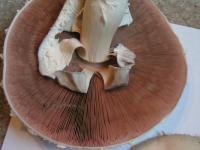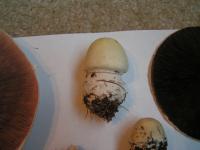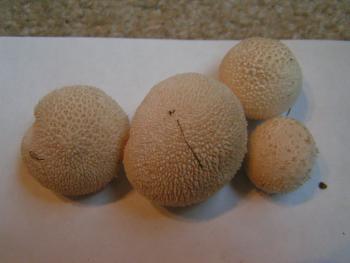Category Archives: Mushrooms
The inside of the Calvatia
Calvatia cyanthiformis
Awesome Find: Young Polyporus squamosus
Generally corky and technically edible, Dryad’s Saddle, or Pheasant’s Back are Polyporus squamosus‘ common names, and it has one of the most interesting properties in the Mushroom kingdom: When cut open, it smells like fresh watermellon rind. Unbelieveable. They also sometimes grow to gigantic size (at one time there was one growining in my grandparents’ yard at the base of a dying maple that was nearly 2 feet across).
The specimens my wife and I found after a heavy rain were also young enough to eat, as when they are soft enough to cut with your fingernails, they’re easy enough to chew.
Unfortunately, they were also too young to obtain a sporeprint…
Since we very strictly adhere to beyond-a-doubt microscopic identification before consuming any mushrooms we find in the wild, this treat will unfortunately meet the trash, much like the first time we came across Agaricus arvensis (a rather choice edible).
When in any doubt, throw it out, and for us, that means matching microscopic criteria. No exceptions.
But hey, they were absolutely gorgeous, and now we know where they grow. More data is needed. 😉
(Note on the last picture, there are some unidentified Coprinus that were deformed due to the heat and sudden dryness after the rains.)
The Pluteus cervinus From the Reishi Stump
This stump consistently grows Pluteus (Deer Mushrooms) and Ganoderma (Reishi) every year in alternating waves. The first to sprout this year was a really sorry looking Pluteus. Where this patch usually gives a nice salmon-pink sporeprint, this scraggly guy is a nice reddish-brown. Both colors are well within P. cervinus limits, and a peek at the spores under a microscope confirms they’re a match.
Coprinus On My Grandparents’ Lawn
Here are some pictures of the Coprinus I mentioned earlier. They’re growing on the subterranean remains of an old elm tree that used to stand in the yard. After the elm got sick and died, and the trunk was removed, Coprinus keep popping up there year after year.
I was lucky enough to snag a sporeprint before the gills liquefied, a picture of which I’ll post here soon.
Mushroom Season Starting Again
First two specimens of the year just came in. One Pluteus cervinus growing out of the Reishi stump, and some Coprinus of some variety that were growing gregariously where the old elm tree once stood on my grandparents’ property.
I’ll have pictures later. 🙂
-Steve
October 25 – The Undentified
Alright, now to go over the mushrooms that I am not 100% certain of:
I am at 95% confidence that the above are Agaricus arvensis or the “Horse Mushroom.” However, 95% is not good enough for me to put it in my mouth, chew and swallow. I’ve picked these before and have posted previous specimens here. In fact, in those previous pictures, I believe that there was a tipoff as to its identity. If you look at the 6th one in the set, in the upper left-hand corner of the image you can see the distinctive “cogwheeling” that is present in A. arvensis‘ ring. The cogwheeling isn’t as distinct in these pictures (although I do believe it’s there), so I still hesitate.
Growing in: Lawn.
Cap: 6-7″ in diameter. Convex to flat. Younger buttons pale yellow-buff to white, older specimens white with buff to tan area towards the center. Very fine compressed shag. Flesh, for the most part not bruising to any color except a very very light brown where the cap connects to the stem.
Gills: Free from the stem and crowded. Very pale in the button stage progressing to gray (with very slight hints of pink, but completely desaturated) and finally dark chocolate brown upon maturity.
Stem: Up to an inch thick similar to any other Agaricus stem with a small bulb at the base (more prominent in buttons). Big floppy ring with some cogwheeling.
Spores: Spore print is chocolate brown. Spores smooth and elliptical. Unfortunately my microscope’s calibration is off at the moment so I cannot distinguish exact size.
Unfortunately, these photos do not show the true vivid colors of these mushrooms. They were brilliant red-orange. I’ll add in more info about them here later.
We also came across some funky, slimy yellow mushrooms, but decided against harvesting any samples, as our basket was (at the time) chock-full of edible goodness.
October 25 – Calvatia
Certainly Calvatia most likely C. cyanthiformis, but all samples were far too fresh to get any spores. Luckily it won’t matter to me as all Calvatia are tasty and good to eat. One of them we found cracked open, exposing its white flesh (probably a deer stepped on it) but it exhibited something fascinating by trying to heal itself closer to its base.

























